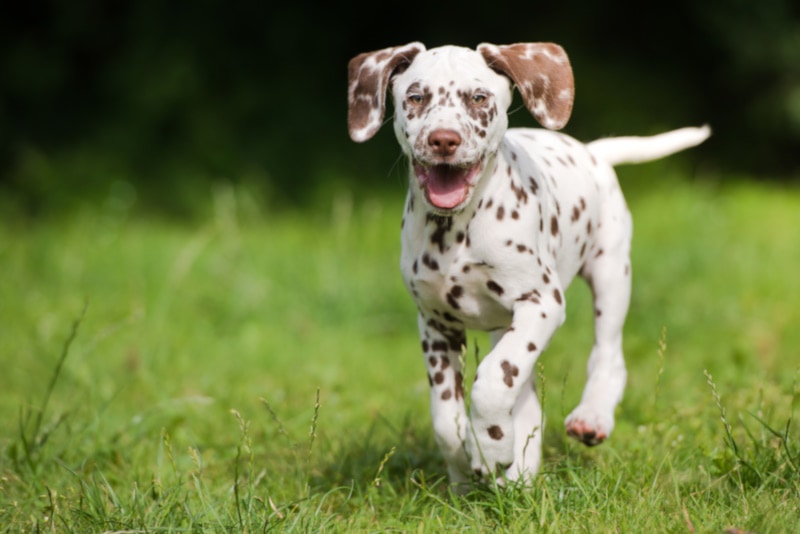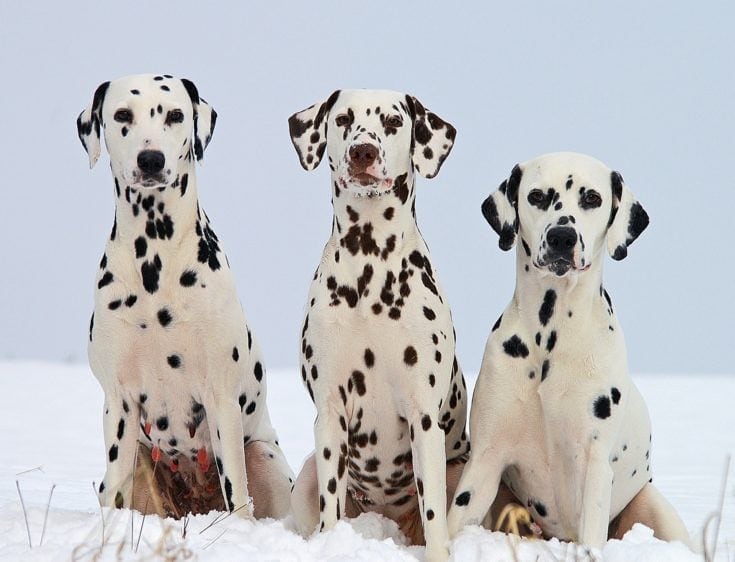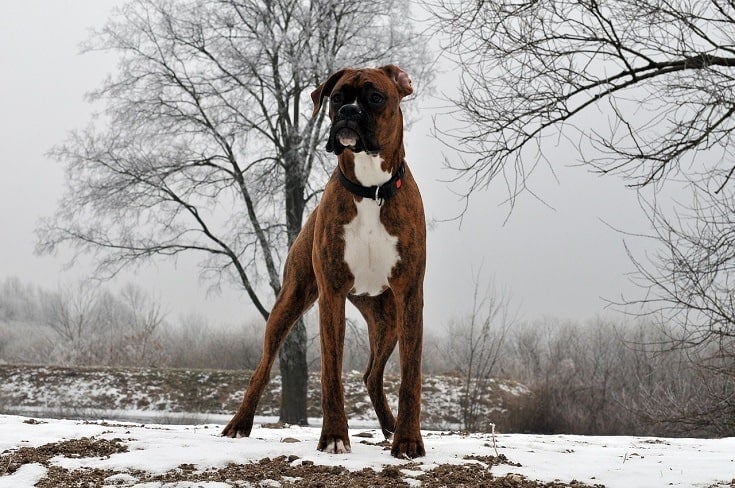Brown (Liver Spotted) Dalmatian: Pictures, Facts & History
By Ashley Bates
Updated on

Click to Skip Ahead
Dalmatians have a rich but mysterious history. We are so used to the classic black-and-white look of the spotted Dalmatian. You might be so used to it that you don’t realize other color options are available.
The brown, or liver-colored, Dalmatian is identical to the black and white Dalmatian in looks—just not in the same shade. They are extremely interesting and very unique in their own right. Here we will discuss this coat color along with other interesting facts about the breed as a whole.
| Height: | 20 – 23 inches |
| Weight: | 45 – 60 pounds |
| Lifespan: | 10 – 13 years |
| Colors: | Black, liver, lemon, sable, brindle |
| Suitable for: | Active families, experienced owners |
| Temperament: | Energetic, loyal, dependable, reserved with strangers |
The liver Dalmatian is a stunning addition to the breed lineup. It is certainly a unique look, unlike what most people are used to. So, if you support one of these dogs, you might get many questions about the overall breed identification.
These dogs never share black or other markings in their coats. It’s simply brown and white, mimicking the black and white coat.
Brown Dalmatian Breed Characteristics
The Earliest Records of Brown Dalmatians in History
Dalmatians as a breed can be traced back all the way to Croatia in a region called Dalmatia, hence the modern name. However, there is no definitive answer on the breed’s origin. The Dalmatian we know today really began to surface in the mid-1800s, leading us to formal acknowledgment from kennel clubs.
However, the earliest possible breed recognition dates back as far as 3700 BC, owned by King Cheops of Egypt—allegedly. There are also old artworks with depictions of spotted dogs which many believe led to the modern-day Dalmatian dog.
Some speculate that the early Dalmatians took two ancient breed sources—the Cretan Hound and Bahakaa Dog.

How Brown Dalmatians Gained Popularity
Dalmatians have a vibrant history—taking on roles like carriage pullers, horse protectors, army sentinels, firehouse companions, and circus performers. While they were quite popular in their day, they have decreased in popularity due to being hard to handle.
Brown was always in the color lineup, although it has never been as common as the standard black and white.
Formal Recognition of Brown Dalmatian
The Dalmatian is an older breed recognized by the AKC in 1888. Later, in 1914, the United Kennel Club accepted this breed into the lineup.
Before the breed was thoroughly understood, they were thought to be unintelligent. Due to their deafness, it challenged many breeders to try to weed out this anomaly. Today, the Dalmatian Heritage Project exists to improve bloodlines, health, and temperament.
Top 7 Unique Facts About Brown Dalmatian
Here are a few fun facts about the Dalmatian breed—brown-colored and otherwise.
1. Brown Isn’t the Only Alternative Dalmatian Color
- Black
- Lemon
- Tri-color
- Sable
- Brindle
So, now you can enjoy this magnificent breed’s beautiful colors!

2. Many Dalmatians Are Deaf
You might have heard before that most Dalmatians are deaf; what you might not know is that this common concept is actually genuine. We listen to myths about specific dog breeds and a slew of other information in daily life, and it’s hard to decipher what is true and what’s false.
This particular situation is rooted in fact. It is estimated that 8% of Dalmatians are bilaterally deaf, and 22% are unilaterally deaf. So, in total, 30% of all Dalmatians experience some deafness.
This issue is so high, in fact, that not even specialized breeding can prevent deafness 100%. However, this doesn’t stop efforts from those who care about the breed, striving to bleed this out of genetics.
3. All Dalmatian Puppies Are Born with White Coats
No matter if your Dalmatian puppy will be liver-spotted, black and white, or otherwise, they are born with pure white coats. They don’t develop their actual spots until much later. According to the AKC, Dalmatian puppies will get their spots at roughly 2 weeks of age.
Then, you can start to admire all of the beautifully unique markings each puppy sports.

4. Dalmatians Have Taken a Plummet in Popularity
As we touched on above, Dalmatians are less popular than they once were. One of the main reasons for this is that they are very challenging dogs to keep. They tend to dislike strangers and sometimes only take to one person.
They also require an extensive amount of exercise and mental stimulation. If they don’t get it, they are notoriously destructive. Since so many of them are deaf, it is also challenging for some inexperienced dog owners to navigate. They tend to not make the best options for children due to their special needs.
5. These Dogs Have Had Multiple Jobs
Dalmatians have worked as hunting dogs, flock shepherds, guard dogs, fire station helpers, and draft dogs. They have certainly had their lineup of duties. They especially made excellent companions for firefighters due to their deaf quality since the sirens don’t hurt their ears.
Even though these dogs are highly skilled in work environments, they are a little more complicated to have as pets. They require a lot of direction and extensive training.

6. 101 Dalmatians Movie Did the Breed a Disservice
101 Dalmatians is an adorable Disney movie we’re all familiar with. However, upon its coming out, it created quite a misconception about the breed.
Many families flocked to buy these dogs, not understanding the responsibility they were taking on. This led to many Dalmatians being homeless or rehomed to new families.
7. Melody, a Dalmatian, Holds a World Record
Dalmatians are also record-holders! Typically, one litter of Dalmatian puppies yields 7 to 10 offspring. Melody, on the other hand, gave birth to 19 live Dalmatian puppies. Now, she holds a record for the largest Dalmatian litter in the world.
Do Brown Dalmatians Make a Good Pet?
Deciding whether a brown Dalmatian will make a good pet for your household greatly depends on your lifestyle. Certain dog breeds are notorious for specific characteristics, so the question is, does it match your home life?
All Dalmatians are highly athletic dogs that require an extensive amount of physical exercise per day. They are not the kind of dog you can keep in a kennel for hours without drawbacks.
Any Dalmatian that isn’t mentally and physically stimulated can develop unwanted behaviors such as separation anxiety and destructive tendencies. Also, although Dalmations make very good playmates for children, they have been known to be slightly aggressive with unknown members outside of the family.
Since Dalmatians are predominantly deaf, it can also cause sensory issues that result in some aggression as well.
Conclusion
Adding a brown Dalmatian to your household can be such an exciting experience! They might be rarer and, therefore, harder to find. But it’s definitely not impossible. They can make extremely good pets for suitable households, so research beforehand.
To ensure this breed makes an ideal fit for your household, make sure your energy matches up. Remember that the brown, or liver, Dalmatian is simply a coat color and has no bearing on personality or breed origin.
Featured Image Credit: Annabell Gsoedl, Shutterstock














